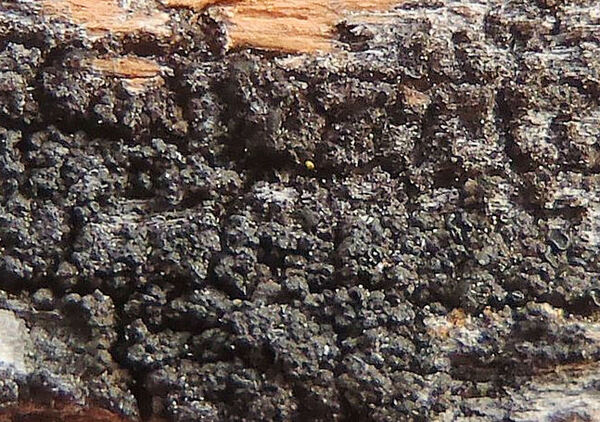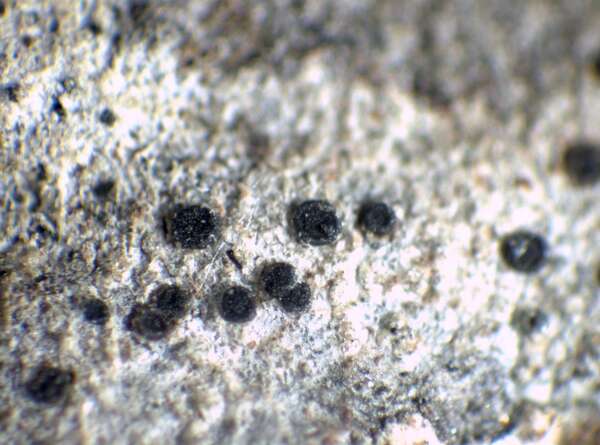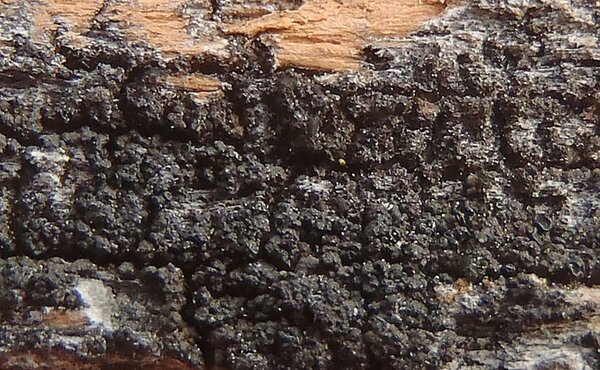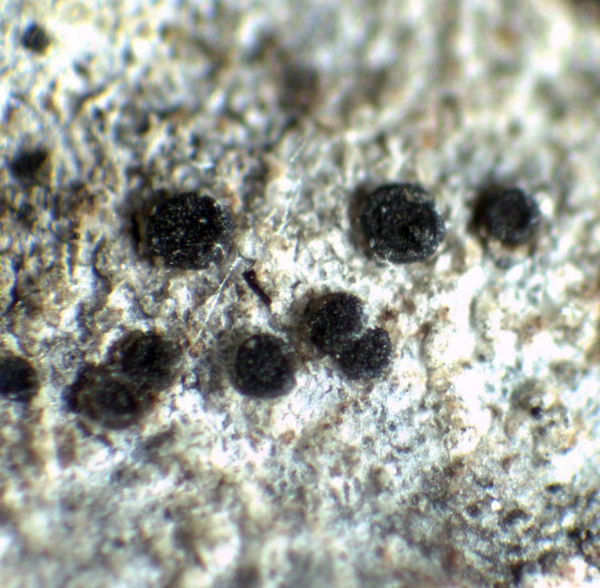Lecidea globulispora Nyl.
Lich. Exot.: 263, 1859.
Synonyms: Biatora antiloga (Stirt.) Walt. Watson; Lecidea antiloga Stirt.; Lecidella antiloga (Stirt.) M. Choisy
Distribution: S - Cal (Puntillo 1996, van den Boom & Giralt 2002).
Description: Thallus crustose, inapparent, fully endosubstratic. Apothecia lecideine, black, 0.15-0.4(-0.6) mm across, sessile and constricted at base, with a flat to slightly convex disc and a raised, persistent proper margin. Proper exciple brown in outer part, colourless within, but filled with minute brown crystals dissolving in K, composed of thin anastomosing hyphae with enlarged, brown-pigmented cortical cells; epithecium brown to dark blue-green, N+ red; hymenium colourless, 30-60 µm high; paraphyses lax in K, simple or sparingly branched in upper part, stout, 2-3 µm thick at mid-level, the apical cells distinctly capitate, up to 5 µm wide, with dark brown caps; hypothecium colourless, but filled with minute brown crystals dissolving in K. Asci 8-spored, clavate, with a K/I+ blue apical dome penetrated by a narrow, K/I– apical cushion surrounded by a narrow, deeply K/I+ blue zone, the wall K/I- but surrounded by an I+ red-brown, K/I+ blue outer layer, the ocular chamber relatively small, Biatora-type. Ascospores 1-celled, hyaline, globose, 4-6 µm wide. Photobiont chlorococcoid, the cells 9-12 µm wide. Spot tests: thallus K-, C-, KC-, P-, UV-. Chemistry: thallus probably without lichen substances.Note: a mainly cool-temperate to boreal-montane lichen also known from the Southern Hemisphere, found on hard, exposed lignum, more rarely on conifer bark; to be looked for in the Alps. According to Printzen (1995) the generic position of this species, related to the North American Lecidea paddensis (Tuck.) Zahlbr., is not clear.
Growth form: Crustose
Substrata: bark and lignum
Photobiont: green algae other than Trentepohlia
Reproductive strategy: mainly sexual
Most common in areas with a humid-warm climate (e.g. most of Tyrrenian Italy)
Commonnes-rarity: (info)
Alpine belt: absent
Subalpine belt: extremely rare
Oromediterranean belt: absent
Montane belt: rare
Submediterranean belt: absent
Padanian area: absent
Humid submediterranean belt: absent
Humid mediterranean belt: absent
Dry mediterranean belt: absent

Predictive model
Herbarium samples


Curtis Randall Björk CC BY-SA 4.0
British Columbia, Chilcotin region, Talla Lake. Photographed from specimen (Goward 81-1466, UBC) on branch of Pinus albicaulis in dry subalpine forest
1981-07-02


P.L. Nimis; Owner: Department of Life Sciences, University of Trieste
Herbarium: TSB (13790)
2001/11/30
Growth form: Crustose
Substrata: bark and lignum
Photobiont: green algae other than Trentepohlia
Reproductive strategy: mainly sexual
Most common in areas with a humid-warm climate (e.g. most of Tyrrenian Italy)
Commonnes-rarity: (info)
Alpine belt: absent
Subalpine belt: extremely rare
Oromediterranean belt: absent
Montane belt: rare
Submediterranean belt: absent
Padanian area: absent
Humid submediterranean belt: absent
Humid mediterranean belt: absent
Dry mediterranean belt: absent

Predictive model
| Herbarium samples |


Curtis Randall Björk CC BY-SA 4.0
British Columbia, Chilcotin region, Talla Lake. Photographed from specimen (Goward 81-1466, UBC) on branch of Pinus albicaulis in dry subalpine forest
1981-07-02


 INDEX FUNGORUM
INDEX FUNGORUM
 GBIF
GBIF



